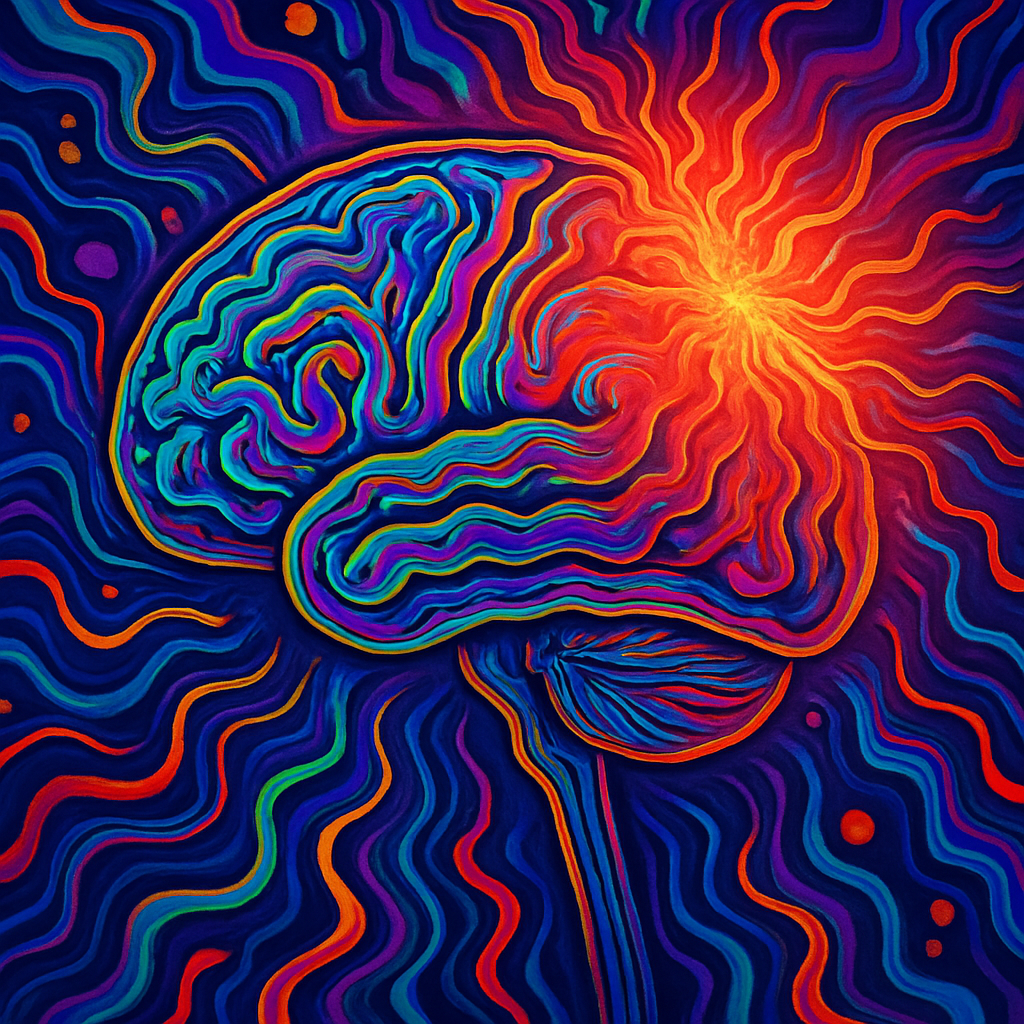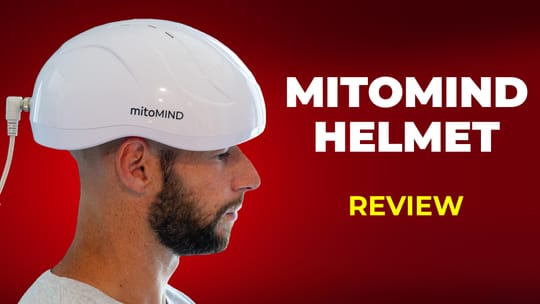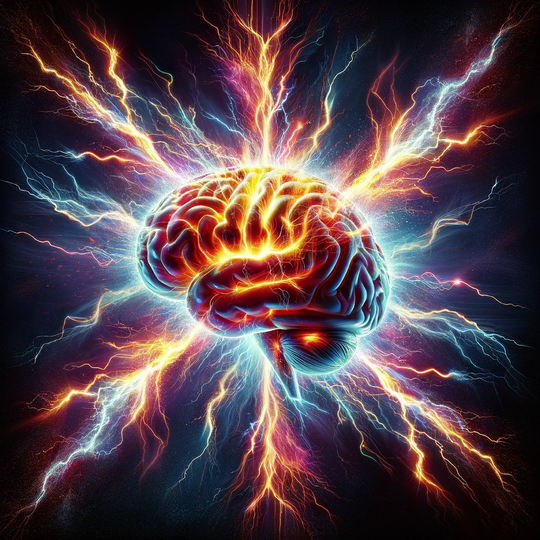Nothing as horrible as a headache - or worse: a migraine! I completely understand. And what's even worse is that there's no bulletproof way to prevent or halt a migraine!
The solution?
Well, maybe red light therapy for migraines can be a wonderful tool in your toolbox!
I'll explain why in great detail in this article. I'll take you by the hand and guide you through all the science on this topic. I'll also give you recommendations for the devices you can best use. I'll also cover questions like:
- "How to use red light therapy for migraines in the best way?"
- "What if you a get headache after red light therapy?"
- "What wavelenght or what color helps with headaches?"
Etcetera!
If you're short on time, just read the summary I've added below. If you want to know my full argument, read the entire article!
Here we go:
Headaches and migraines are a huge problem in society. About 15% of the global population is affected by them and 90% of people suffering from them have their daily life affected. And about 1.5-2% of the population have chronic migraines, which are even more debilitating.
Migraines can be triggered and worsened by many factors, such as stress, medication overuse, sleep distrubances, neuroticism, or plain randomness! Nevertheless, people with migraines do have changes in the nervous system, such as neuroinflammation, increased sensitization of certain (pain) pathways, and more. Current treatments involve pharmaceuticals and lifestyle changes but these often don't fix the issue.
So, that's where red light therapy is needed! Both red and green light are very promising here. Red light therapy with the wavelengths between 635 and 904 nm show benefit on acupuncture point applications and intravenously (directly into your bloodstream). In these preliminary studies, good results are achieved for how frequently you have a headache or migraine, its severity, and the amount of medication you'll need.
Overall, the outcomes are great! However, far more research is needed with higher-quality studies to draw stronger conclusions. With current studies, it's also highly likely that many treatment protocols that work really well haven't been discovered yet. With red light therapy, you may want to treat the neck and trapezius region that has some evidence and is easier to apply for many people. Some of the studies use more complicated application protocols, such as the intravenous 635 nm light therapy of lasers on acupuncture points - these cannot be replicated by most consumers. So I recommend keeping it simple!
Then there's green light therapy. Green light therapy (500s - 600 nm, give or take!) has also demonstrated pain reduction and improved sleep and anxiety outcomes, especially in responsive individuals, with no major side effects. As green light therapy is cheap, it's very much worth trying in my opinion!
As always, don't neglect lifestyle and nutrition - yes I say that in almost any article I write. Here, there's some evidence-base for supplements like magnesium, vitamin B2, and CoQ10, and treatments like acupuncture. These therapies can really move the needle in a meaningful way!
If you need an introduction to what these terms mean, check the following resources:
- What Is Red Light Therapy?
- Red Light Therapy Explained: Basic Terms Guide
- Start Here - Light Therapy 101 & Buyers Guide
- Red Light Therapy Dosing Chart: The Raw Data From Hundreds Of Studies
- Red Light Therapy Dosing: Why It's Complicated!
- Red Light Therapy Wavelengths Benefits: The Ultimate Guide
- How Often Should You Use Red Light Therapy Explained
These resources should give you a basic understanding of how red light therapy works, and the discussions around it!
The picture at the beginning of the article is AI-generated though!
The Burden Of Migraines: An Introduction
First, I'll start with some statistics to help you visualize the problem. It turns out that headaches and migraines are quite a big problem in society - and many peope suffer in silence:
Basic Migraine Statistics
Migraines are a horror. Migraines are very intense headaches. About 15% of the world's population is affected by migraines - women double the number of men (1; 2). Unlike most health conditions, however, migraines affect young people most (3). I still remember when I was doing my bachelor's degree in physical therapy and my good friend often needed to call in sick because of migraines.,
Hard to understand for people unaffected!
Now, here's a shocking fact that you may not know: headaches are among the leading causes of disability around the world (4). About 7% of people affected by migraines have them more than 15 times a month (5). With such strong headaches so frequently, you're basically incapacitated to work properly - hence disability!
If you look at the statistics, that's precisely what you'll find - about 90% of people with migraines are unable to work (6). Looking at the world as a whole 1.4 - 2.2% of the entire world's population has chronic migraines - so it's a big problem that should ideally be solved (7).
Let's consider some recent reviews on thist topic:
Migraines As A Pathology
I've only included very recent reviews of the last five years here. Reviews analyze and integrate previous studies on a topic. That way you'll get a great understanding of the condition in general.
What's striking is that imaging and diagnosis is generally not necessary for this condition (8). Someone with migraines will tell you when they're in great pain. But how are the migraines caused?
Paradoxically, many migraine-sufferers talk about light as a trigger (9):
"Light is commonly reported as a trigger factor of migraine attacks, however, early manifestation of photophobia and false attribution is likely the actual cause based on data deriving from retrospective, prospective, and experimental studies. The most common photophobia symptoms in migraine are exacerbation of headache by light and abnormal sensitivity to light with the underlying neural pathways likely being dependent on ongoing activity in the trigeminovascular system. Clinical studies and experimental models have identified mediators of photophobia and uncovered narrow wavebands of the light spectrum that may reduce pain intensity during a migraine attack" (9)
But, it would be more correct to say that light is both a trigger and a prevention or cure. I'll come back to that topic soon. Studies also question whether light really is a trigger and assume that people perhaps falsely attribute light to triggering a migraine (9).
Neuroticism, as a psychological trait, may also cause migraines (10). Neuroticism is linked to baseline levels of anxiety and emotional disorder (10). Remarkably, neuroticism also seems to be linked to migraine risk (10). And, migraine patients often have higher levels of neuroticism (10). However, the causes of migraines are complex and not fully understood right now (11).
Chronic migraines are linked to a ton of different risk factors such as (12; 13; 14):
- Overuse of migraine medication
- Obesity and metabolism-related conditions
- Depression and psychiatric conditions
- Poor respiratory health
- Stressful life events (or financial stress)
- Age (for chronic migraines)
- Educational status
- Other pain conditions
- Sleep disturbances
- Low physical activity
- Smoking
- High caffeine intake
Over time, migraines–even acute ones–will lead to other conditions, such as depression, sleep problems, and even suicide in some cases (15). Different types of migraines also exist - those with and without an aura (16). Auras here, mean that you'll have sensory alterations from an hour before the migraine sets in, such as flashing lights or blindspots. The benefit is that you can immediately treat the condition before the migraine sets in.
Let's check what's commonly used for migraines:
Migraine Treatment
By understanding the progression of a migraine, you'll better understand treatment (16). Normally, migraines go through four stages, and treatment aims to influence these stages:
- Early period, where there can be fatigue or other symptoms
- Aura period (not in all migraine sufferers!)
- The actual migraine
- Post-migraine period
You'll end up with functional impairment because of the throbbing pain - at one side of the body. People also often avoid the light and louder noises (16).
Of course, it's always best to prevent a migraine. And, if you've got a migraine anyway, then it's smart to counteract it as quickly as possible. So, treatment here concerns all these stages. In the first two stages listed above, the goal is to prevent the migraine from occurring. During the actual migraine, the goal is to abort it as quickly as possible.
For the first phases, a few non-pharmacologic strategies are invaluable. Here, you can include lifestyle changes such as regular sleep, hydration, exercise, stress reduction, getting sufficient food in, and identifying triggers. Tools like headache diaries can help monitor frequency and response to interventions, thereby potentially preventing headaches.
But lots and lots of pharmacological options exist for preventing migraines as well (16)! Here you can think about anti-epileptic medication, antidepressants, blood pressure medication (beta blockers), medication against high blood pressure, and even Botox treatments in the face. Botox can make facial muscles more relaxed, thereby avoiding migraine triggers.
During acute migraines, pharmaceuticals are often the main course of action (16). These are painkillers like NSAIDs and acetaminophen (ibuprofen). Triptans, which stimulate serotonin. Serotonin is a whole other story - it's a very complex brain-signalling compound not just responsible for "wellbeing" as commonly thought. Then, there are newer pharmaceuticals that restrict blood flow (vasoconstriction), such as 5HT1F agonist and CGRP antagonists. Tons of new solutions are being developed here, such as even intravenous (directly into the blood) medication (16)!).
The simple version is, once you've got a migraine, the pharmaceutical solution to stop the pain becomes obvious!
However, treatments still aren't effective in aborting existing migraines in most cases! The same is true for the frequency of migraines. Part of that problem originates in poor adherence with medication and lifestyle factors, but part also in the poor functioning of medication for migraines!
Exercise seems to work well to counter both migraine intensity and duration, for instance (20). Other interventions, such as going to a physical therapist and getting spinal manipulation don't have any evidence behind them at all (21). I can know as I was educated as a physical therapist!
Next up:
Migraines And Structural Brain Changes
How and why migraines develop isn't fully understood (17). Here's what researchers state about the process:
"Mounting evidence on aberrant alterations suggest that pronounced functional and structural brain changes, central sensitization and neuroinflammation may underlie chronic migraine mechanisms." (17)
Surprise, surprise!
There's that "neuroinflammation" again - or nervous system inflammation. I've discussed that topic in my articles on red light therapy for Parkinson's and red light therapy for epilepsy. This is a good finding as red light therapy - as will soon turn out - has a big potential effect on neuroinflammation.
However, not all headaches are the same. Some headaches originate because you've got another health condition (18). Other headaches may be triggered by the trigeminal nerve - one of the 12 nerves arising from the brain itself - that gives rise to gruelsomely painful headaches (18). Some other types of migraines are paired with anxiety disorders (19).
Here's what researchers state about recent developments on migraines in the brain:
"It has become clear that migraine is a neural disorder, in which a wide range of brain areas and neurochemical systems are implicated, producing a heterogeneous clinical phenotype. Many of these neural pathways are monoaminergic and peptidergic, such as those involving calcitonin gene-related peptide and pituitary adenylate cyclase-activating polypeptide. We are currently witnessing an exciting era in which specific drugs targeting these pathways have shown promise in treating migraine, including some studies suggesting efficacy before headache has even started" (22).
So, structural changes in the brain are currently found in people suffering from migraines (23; 24; 25)! That's great news because it proves that migraines aren't all in your head - so to speak! This is another case just like fibromyalgia, whereby researchers were highly skeptical about the existence of the condition decades ago, where there's now proof that the condition is real.
Next, let's look at what red light therapy is. Then you'll understand why it has a lot of promise for migraines in the future:
What Is Red Light Therapy?
Red light therapy uses both red and near infrared from the light spectrum. Those wavelengths of light don't just hit your skin but enter your body. That way, red and near-infrared light can affect you at the cellular level.
In the cell and other structures, red light therapy improves energy production while lowering inflammation. Higher levels of inflammation are not only tied to many chronic diseases but also lower energy levels. By reducing inflammation, many people feel and perform a lot better.
Red light therapy has tons of different effects for different conditions and health goals. Whether it's joint pain, or sports performance, or skin rejuvenation, red light therapy has an impact on it. The same is true for neurodegenerative diseases and nervous system conditions. I've written a few articles where red light therapy has a small to large effect, such as:
- Red Light Therapy For Parkinson's Disease: A Hopeful Strategy!
- Red Light Therapy For Epilepsy: Current Science Explained
- Red Light Therapy For Fibromyalgia: Incredible Pain Relief & Much More!
- Red Light Therapy For Upgrading Your Brain Health
- Red Light Therapy For Neuropathy: The Promising Science
- Red Light Therapy For Depression: A Potential Solution
Today, I'll do the same for migraines:
How Red Light Therapy May Help Migraine Sufferers: Breakdown Of All Current Studies
Here I'll break down the methodology and outcome of all the migraine and headache studies out there right now. I've used Vladimir Heiskanen's excellent Excel sheet for this, where 8,000+ light therapy studies are categorized right now (26).
Ten studies have been published on this topic currently (26). Here's the outcome:
- First, a 635 nm study using intravenous light - so directly into the bloodstream (27). The 24 participants were split into two groups. The researchers used single-photon emission computed tomography (SPECT) to measure blood flow around the organs, such as in the brain. The placebo group received an exercise program, education, and more, while the intervention group received the light therapy (28). The finding here is that the light therapy group improved pain, cognition, disability, sleep quality, and the regional blood flow in the brain that's often affected with migraines. The researchers do note that the intravenous red light therapy is novel for this goal, but, mention that Russian researchers have used this therapy for decades (I just sent a newsletter out on this topic last weekend!) More research is needed here, however, with better study quality. But these results are very impressive already!
- Secondly, there's an 808 nm study that compares light therapy with Botox injections (29). A very high 120 J/cm2 dose was applied to very small areas across the face, neck, and trapezius muscle (30). There were 10 sessions, twice per week. Below, you can see the massive decline in medication use and overall pain with both therapies:

- And then, there's a graph of the anxiety levels (jitters) and sleep disorders:

- So these are huge improvements over the course of a little more than a month! Very promising!
- Thirdly, there's an 830 nm study whereby the light is applied to acupuncture points with a laser in children (31). There were four weekly treatments over four weeks and the control group received a sham laser intervention. Here's the incredible outcome that the researchers found:
"Measurements were taken during 4 weeks before randomization (baseline), at weeks 1-4, 5-8, 9-12 and 13-16 from baseline. The mean number of headaches per month decreased significantly by 6.4 days in the treated group (p<0.001) and by 1.0 days in the placebo group (p=0.22). Secondary outcome measures headache severity and monthly hours with headache decreased as well significantly at all time points compared to baseline (p<0.001) and were as well significantly lower than those of the placebo group at all time points (p<0.001). We conclude that laser acupuncture can provide a significant benefit for children with headache with active laser treatment being clearly more effective than placebo laser treatment." (31).
- So, that's three very promising outcomes for headaches and migraines with red light therapy!
- Another laser acupunture study uses 830 nm in adults (32). The placebo group received treatment with a sham laser. Here's the incredible outcome once again. The number of attacks, the duration of the attacks, and the days in the month participants in the intervention group were affected improved dramatically:
"There were significant differences between groups (P<0.001) in changes from baseline in months one, two and three, in median score for headache intensity (treatment group -5, -3 and -2, placebo group -1, 0 and 0), median duration of attacks (treatment group -6, -4 and -4, placebo group -1, 0 and 0 hours), and median number of days with headache per month (treatment group -15, -10 and -8, placebo group -2, 0 and 0)." (32)
- So, in the first month, the treatment group had far lower pain intensity (-5), lower median duration of the attack (-6), and 15 days fewer affected by the headaches, which is half the month. Again, super impressive results!
- Then, a 904 nm light therapy study compares TENS (a pain-technology device), light therapy, and acupunture (33). All therapies lead to results, with acupunture leading here. Not much is known about the treatment parameters, however.
- Another 904 nm study that didn't find significant differences between the control and intervention group (34).
- One more 633 nm study used laser acupunture as well with decent results, but the treatment protocol isn't well described (35).
- Then, a 670 nm where also specific acupuncturethe spots were irradiated with light (36). The neck and facial nerves (the cervial and trigeminal nerves) received light. Headache intensity was reduced here.
So far, so good, but still an extremely wide variety of different treatment protocols. You can see, however, that the first studies I covered–which are chronologically latest published–have extremely impressive results.
These results do need to be verified in studies with more participants and better study setups. But, if you look at what has been published so far, the results are very promising that light therapy may be a modality that helps people with headaches and migraines int he near future!
Here's what a recent review interprets the science I just considered:
"Four randomized clinical trials were included. Most of the included studies had an overall high risk of bias. Compared to sham treatment, photobiomodulation had a clinically important effect on pain in individuals with primary headache. Despite the benefits reported for other outcomes, the estimates were imprecise, and the certainty of the evidence was graded as low. These findings are considered insufficient to support the use of photobiomodulation in the treatment of primary headache." (37)
However, like often in medicine, the researchers intpret the absence of multiple high-qualty Randomized Controlled Trials (RCTs) - which have an intervention and control group - as the absence of all evidence. I do think that the studies I've considered above are very meaningful but I don't think you have to avoid recommending red light therapy.
Also, there's one more thing I need to mention, green light therapy also has a great track record for migraines:
Green Light Therapy For Migraines
I won't go into great detail here, but in several studies, green light therapy for migraines works extremely well (38; 39; 40; 41). This is because the eye seems to respond differently to green light (39). The effect is non-visual, meaning that colorblind people also respond to this therapy (38).
You need green light in the low 500 nm range her. One study uses 520 nm (42). That light needs to emit about 10 mW/cm2. Here, some people respond really well to the therapy while others do not. With a two-hour treatment of that lamp, there's relief of pain, less fear of bright light, a reduction in anxiety and enhanced sleep quality (40). Here you can see the differences between the responders and non-responders - "NbGL" here means "Narrow-band Green Light":

So that outcome is very impressive - if you're a responder to the light. It's worth trying because the green light is super inexpensive to buy.
Another study cuts headache days into a third with green light (41). Quality of life also improves, as does the duration of the headaches. And, there are no significant side effects, most importantly! Again, much more research is needed here but current outcomes are already really promising
Research Insights: Efficacy Of Red Light Therapy In Migraine Treatment
So, "is red light therapy good for migraines?" Overall, there's some evidence that light therapy for migraines! And, in many of the studies, there are literally life-changing effects, even though many studies only use a short treatment period. You and I need:
- Longer-term studies
- More high-quality studies
- Studies on different wavelengths, including green light
To confirm these outcomes. Nevertheless, many people already have very good experiences with the protocols listed above. So let's talk a bit more about how you can implement these protocols:
Treatment Protocols: How To Use Red Light Therapy For Migraines at Home
Finally, how to use red light therapy for migraines? There's no easy answer here. For instance, the first study I discussed above uses 635 nm light intravenously, and 99.99% of people don't have access to such a device. Something that comes close, however, is the Endolight that the owner of this website Alex Fergus has discussed here:
The second study uses lasers at specific acupunture points. So, theoretically, you could buy a laser such as the one Alex has discussed here:
However, applying the laser to specific acupuncture points is going to be very complicated. Hence, once again, the option above isn't an easy answer.
Likely, the best option you'll have is to use a handheld red light therapy device such as the ones Alex has reviewed below, and use them on the trapezius muscles above your shoulder blades, neck, and potentially parts of your face (if tolerated!):
I don't have an easy answer here, to be honest! You may find that some protocols work extremely well from self-experimentation. Also, consider getting a Hooga Green Light Therapy device that's dirt cheap and may be life-changing as well:
For a Hooga green light therapy click HERE: https://aferg.co/hooga-rlt - code ALEX saves
Red Light Therapy Vs. Traditional Migraine Treatments
I'm a bit skeptical of the framing of the question of "red light therapy vs. traditional migraine treatments". Why? Simple: you don't have to choose! You can use both avenues of treatment. And there's some incredible evidence for other alternative migraine treatments, such as:
- Magnesium has an incredible track record for migraines (42; 43; 44; 45; 46). Some studies literally claim that all people with headaches and migraines should be treated with magnesium, which I agree with (42). The reason is that magnesium supplemention is dirt cheap - it will cost you maybe $10-20 USD a month and can relieve migraines in many people. I've personally had great success with magnesium for the people in my life. Take a magnesium glycinate, magnesium taurate, magnesium malate, or magnesium threorenate form - you can buy directly from Amazon HERE. Up to half of people with migraines are magnesium-deficient, and magnesium is the anti-stress and relaxation mineral of the body (42). One review writes:
"five clinical trials fulfilling the selection procedure were found. One out of two Class I evidence trials showed a significant reduction of the number of migraine attacks compared with placebo, while two out of three Class III trials evinced a statistically significant reduction of the primary efficacy parameters compared with placebo." (43).
- For greater effectiveness, you can even use intravenous magnesium, although you'll probably need a nurse for adminitering the therapy here (44). Magnesium is great for both prevention and treatment (45; 46).
- Acupuncture can be highly effective for migraines, even in the long-term for prevention. Many studies have been published on this topic recently (47; 48; 49; 50; 51). Reviews that look at many earlier studies are super positive, for instance (47; 48; 50). In some migraine cases, magnesium may work better and in other cases acupuncture–but both are decently affordable options–depending on whether you have migraines with an aura or not. Pain during migraines goes down, as well as the frequency of attacks, and the duration of the attacks - so these are three independent benefits (47)! Here's a quote from another review:
"we found high quality of evidence indicated that the effective rate of acupuncture was superior to western medicine in treatment of migraine. Besides, acupuncture reduced more headache days and the times of using painkiller and was more effective in reducing the frequency and degree of headache than western medicine and sham acupuncture." (48)
And, another review states:
"Four studies revealed acupuncture is just as effective and has fewer side effects than any western medicine. Acupuncture can be recommended as an alternative or adjunct to drug treatment for patients suffering migraines." (50).
- Use painkillers strategically. Use common sense here!
- Serotonin-agonists - which stimulate the serotonin levels or uptake by nervous system cells (52). Ask your doctor on how to use these, but these can be very helpful in acute headaches and migraines.
- A high dose of vitamin B2, or "riboflavin", at 400 mg per day (53; 54; 55). This B vitamin can reduce the frequency of migraines, their intensity, and duration. So, that's a win-win-win. Make sure to take the B2 vitamin over the course of three months (53). For balance in your B-vitamin intake, also take a B-complex - because other B-vitamins may deplete when you take too much B2. The vitamin B2 therapy works better in adults than children (55).
- Coenzyme Q10 reduces the frequency and the duration of headaches and migraines, according to two separate reviews (54; 55). You can find that supplement almost anywhere in stores near you, but can also order it off Amazon.
- Some new medication classes, such as "CGRP Inhibitors", beta-blockers (traditionally used for blood pressure), and anti-seizure medication may work well too. Ask your doctor about these options - this is not really my expertise. I do recommend you try the natural pathways first, that I've talked about above, as there's literally zero risk in trying those options!
Conclusion: Less Headaches With Red Light Therapy!
Well, the first wonderful steps have been taken in the red light therapy! Both red and green light therapy for migraines have some extremely promising studies that will have people with this condition jumping in the air from happiness!
Then what about side effects?
You may wonder: "can red light therapy give you a headache"? The answer here is likely "no"! At least, that's not what we see in the studies! So, the therapy is very well worth trying in my opinion!
That statement brings me to the final topic: you may need some trial and error to find out what works for you. The published literature simply has too many studies with complex protocols, such as lasers at acupressure point. That's not option for the average person, hence, I recommend keeping it easy such as treating your upper back and neck region with red light therapy to begin with. Maybe you could even use a full-body panel and only focus on your head, for instance. The opportunities are endless.
And let me know what works for you.
I really want to know!
Join the conversastion in our Facebook group below:
Items Mentioned:
✅ If you want a Weber Endolight, use discount code ALEX and the following link
✅ Get a 5% discount off the Gigalaser and 10% off the Powerlaser, using discount code ALEX and the following link - NOTE: you'll have to contact Powermedic and talk to them and mention discount code ALEX, as you cannot order directly off the website!!
✅ For handheld red light therapy devices click HERE.
✅ For a Hooga Ultra 360 click the following link - code ALEX saves
✅ B complex vitamins
✅ Magnesium and riboflavin combination
✅ CoQ10 supplement
This is a post by Bart Wolbers of Lighttherapyinsiders. Bart finished degrees in Physical Therapy (B), Philosophy (BA and MA), Philosophy of Science and Technology (MS - with distinction), and Clinical Health Science (MS), has had training in functional medicine, and is currently chief science writer.
Found This Interesting? Then You Might Like:
- Discount Codes, Deals & Recommendations - Red Light Therapy
- Red Light Therapy For Parkinson's Disease: A Hopeful Strategy!
- Red Light Therapy For Epilepsy: Current Science Explained
- Red Light Therapy For Fibromyalgia: Incredible Pain Relief & Much More!
- Red Light Therapy For Upgrading Your Brain Health
- Red Light Therapy For Sleep: The Science of Sweet Dreams
- Red Light Therapy For Neuropathy: The Promising Science
- Does Vielight Work? A Close Look At The Spectacular Vielight Science
- Neuradiant 1070: Red Light Therapy For Your Brain?
- Red Light Therapy For Depression: A Potential Solution








